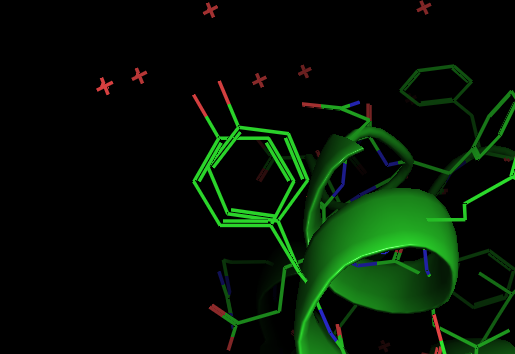2.1 3D structure of biological molecules
Contents
Download 3D structure of protein
In order to perform MD simulation of a protein, we first need to obtain the 3D structure of the protein. If the structure of the protein you want to study has already been determined by experiments such as X-ray crystallography, NMR, and cryo-electron microscopy (cryo-EM), you can download it from the Protein Data Bank (PDB). Let’s go to the PDB website. A huge number of structures of biomolecules such as proteins and nucleic acids are available from this website.
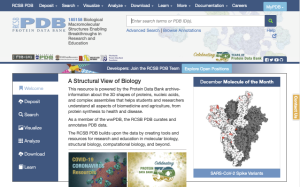
As an example, let’s look for the 3D structure of the “human insulin”. You can search for the protein name in the search box at the top of the page. However, you will find a very large number of entries related to the insulin. For this tutorial, we would like to search one of the representative structures, whose PDB entry is “3I40”. Let’s search for “3I40”. In the page for PDB ID: 3I40, you will see a cartoon figure of the protein on the left side, and also you can see that the structure was determined by X-ray crystallography with a resolution of 1.85 Å.
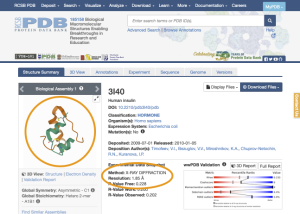
Now, let’s download the structure file of this protein. Such file is called “PDB file”. Click on the “Download Files” button, and then click on “PDB format” to download the file.
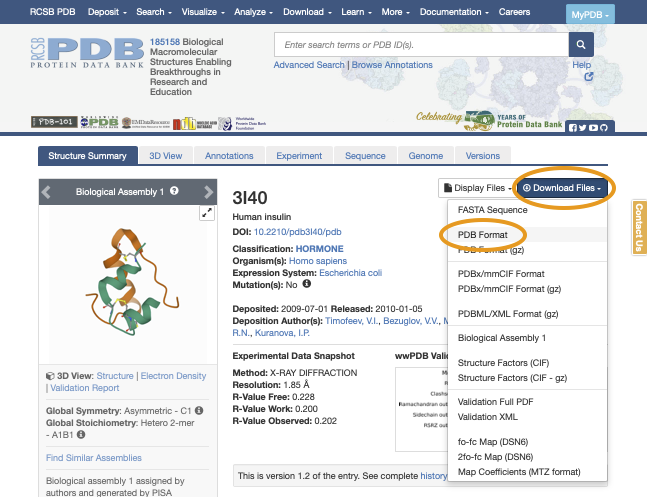
Let’s put the downloaded file in the “Data/PDB” directory.
# Download the PDB file to the Data/PDB directory
$ cd ~/GENESIS_Tutorials-2019
$ cd Data
$ cd PDB
$ mv ~/Downloads/3i40.pdb ./
Alternatively, you can quickly download the PDB file using the wget command. Please right-click on the “PDB format”, select “Copy link address” from the menu to copy the URL, and then run the wget command for the copied URL as follows:
# Download the PDB file using the wget command
$ wget https://files.rcsb.org/download/3I40.pdb
Take a look at the PDB file
Let’s take a look at the contents of the PDB file using the less command. The header part of the file contains various information such as the resolution of the structure, name of the software used for the structure refinement, author’s name, and experimental conditions. After that, there is information about where the disulfide bonds exist, etc. Then, we can see the X, Y, Z coordinates of each atom in the protein. The lines starting with “ATOM” are for proteins, and the lines starting with “HETATM” are for non-protein molecules. In these sections, the 2nd through 9th columns are the atom index, atom name, amino acid residue name, chain index, residue number, and X, Y, and Z coordinates, respectively. For more information about PDB format, please refer to this page.
# Take a look at the PDB file using the less command
$ less 3I40.pdb
:
REMARK 2 RESOLUTION. 1.85 ANGSTROMS.
REMARK 3
REMARK 3 REFINEMENT.
REMARK 3 PROGRAM : PHENIX (PHENIX.REFINE)
REMARK 3 AUTHORS : PAUL ADAMS,PAVEL AFONINE,VICENT CHEN,IAN
:
REMARK 200 EXPERIMENT TYPE : X-RAY DIFFRACTION
REMARK 200 DATE OF DATA COLLECTION : 10-MAR-09
REMARK 200 TEMPERATURE (KELVIN) : 100
REMARK 200 PH : NULL
:
:
SSBOND 1 CYS A 6 CYS A 11 1555 1555 2.03
SSBOND 2 CYS A 7 CYS B 7 1555 1555 2.04
SSBOND 3 CYS A 20 CYS B 19 1555 1555 2.04
:
ATOM 1 N GLY A 1 -27.279 6.238 -12.314 1.00 45.01 N
ATOM 2 CA GLY A 1 -26.249 6.028 -11.313 1.00 43.47 C
ATOM 3 C GLY A 1 -25.582 4.677 -11.471 1.00 34.37 C
ATOM 4 O GLY A 1 -25.731 4.023 -12.501 1.00 30.09 O
ATOM 5 N ILE A 2 -24.853 4.248 -10.446 1.00 32.71 N
ATOM 6 CA ILE A 2 -24.070 3.023 -10.550 1.00 22.60 C
ATOM 7 C ILE A 2 -24.915 1.786 -10.840 1.00 23.32 C
ATOM 8 O ILE A 2 -24.469 0.865 -11.529 1.00 26.36 O
ATOM 9 CB ILE A 2 -23.208 2.791 -9.302 1.00 28.24 C
ATOM 10 CG1 ILE A 2 -22.249 1.620 -9.538 1.00 25.03 C
:
HETATM 414 O HOH A 22 -29.500 -7.696 -14.149 1.00 50.68 O
HETATM 415 O HOH A 23 -11.374 10.214 -16.391 1.00 40.62 O
HETATM 416 O HOH A 24 -11.187 9.560 -19.007 1.00 44.09 O
:
Learn more about the PDB structure
Let’s take a closer look at the contents of this PDB file, since this is a good opportunity to learn more about the PDB structure. In this PDB file, we cannot find any hydrogen atoms. This is because in X-ray crystallography it is difficult to capture hydrogen atoms. In fact, X-rays are poorly scattered by hydrogen atoms because they have only one electron. On the other hand, if we look at the structure determined by NMR (e.g., PDB ID: 2JV1), we can find hydrogen atoms, and also find more than 10 structure models in one PDB file. This is because the NMR structure is modeled based on the information about the distances between nearby hydrogen atoms. In fact, in the structure modeling, simulated annealing MD simulations are performed with geometric constraints on the NMR-derived distances and dihedral angles. The multiple models contained in one PDB file represent low energy structures obtained from a large number of simulated annealing MD runs.
Now, let’s go back to the PDB structure of 3I40. Interestingly, if we look at Tyr14, we can see two different conformations, A (red) and B (blue), which are called “alternative conformations“. This is presumably because the single conformation could not be determined for this side-chain due to its intrinsic flexibility. If you are going to perform MD simulations using the structure that contains multiple conformers, please do not miss it. Probably, you will select one of them. For detailed treatment, see Tutorial 5.
:
ATOM 89 CD1 LEU A 13 -11.104 -1.386 -12.388 1.00 18.06 C
ATOM 90 CD2 LEU A 13 -9.522 -1.530 -14.308 1.00 15.25 C
ATOM 91 N TYR A 14 -13.550 1.075 -15.632 1.00 19.94 N
ATOM 92 CA TYR A 14 -13.559 2.521 -15.774 1.00 22.72 C
ATOM 93 C TYR A 14 -14.638 3.140 -14.893 1.00 22.64 C
ATOM 94 O TYR A 14 -14.391 4.094 -14.152 1.00 25.33 O
ATOM 95 CB ATYR A 14 -13.771 2.911 -17.239 0.50 27.81 C
ATOM 96 CB BTYR A 14 -13.786 2.928 -17.233 0.50 27.85 C
ATOM 97 CG ATYR A 14 -13.608 4.388 -17.494 0.50 28.31 C
ATOM 98 CG BTYR A 14 -13.829 4.427 -17.427 0.50 28.20 C
ATOM 99 CD1ATYR A 14 -12.442 4.893 -18.059 0.50 23.25 C
ATOM 100 CD1BTYR A 14 -12.714 5.121 -17.879 0.50 25.75 C
ATOM 101 CD2ATYR A 14 -14.614 5.282 -17.153 0.50 28.36 C
ATOM 102 CD2BTYR A 14 -14.980 5.152 -17.138 0.50 27.68 C
ATOM 103 CE1ATYR A 14 -12.289 6.252 -18.283 0.50 27.32 C
ATOM 104 CE1BTYR A 14 -12.746 6.496 -18.047 0.50 27.49 C
ATOM 105 CE2ATYR A 14 -14.472 6.636 -17.372 0.50 29.32 C
ATOM 106 CE2BTYR A 14 -15.021 6.527 -17.300 0.50 28.26 C
ATOM 107 CZ ATYR A 14 -13.311 7.117 -17.938 0.50 29.06 C
ATOM 108 CZ BTYR A 14 -13.902 7.193 -17.757 0.50 29.57 C
ATOM 109 OH ATYR A 14 -13.179 8.469 -18.153 0.50 33.01 O
ATOM 110 OH BTYR A 14 -13.938 8.561 -17.922 0.50 32.79 O
ATOM 111 N GLN A 15 -15.837 2.584 -14.969 1.00 21.27 N
ATOM 112 CA GLN A 15 -16.962 3.129 -14.222 1.00 21.51 C
:
Multiple conformers in the PDB structure
Download PDB files for GENESIS tutorial
In Tutorial 3 and later, we will perform MD simulations for several selected biomolecules (Protein G, alanine-dipeptide, Ala3, etc.) as the common targets. Let’s download these PDB files from the PDB website to the “Data/PDB” directory by executing the following commands. Here, alanine-dipeptide and (Ala)3 are small peptides, whose PDB files are actually not available on the PDB website. You can download them from the GENESIS website, which were created by us for the purpose of running GENESIS tutorial.
# Move to the Data/PDB directory
$ cd ~/GENESIS_Tutorials-2019
$ cd Data
$ cd PDB
# Download Protein G (PDBID: 2QMT)
$ wget https://files.rcsb.org/download/2QMT.pdb
# Download alanine-dipeptide
$ wget https://www.r-ccs.riken.jp/labs/cbrt/wp-content/uploads/2019/06/ala2.pdb
# Download (Ala)3
$ wget https://www.r-ccs.riken.jp/labs/cbrt/wp-content/uploads/2019/06/ala3.pdb
Before moving on to the next tutorial, let’s check the structure of these proteins using molecular viewer software such as VMD, PyMol, and Chimera.
What is needed to run simulations?
Now, we got the 3D structure of the target protein. Some of you may want to run MD simulations of the protein in water. However, the protocol for modeling such a system is very complex. If you are using the X-ray crystal structure for the protein, it is necessary to add hydrogen atoms to the heavy atoms. In addition, you have to place water molecules around the protein to make a water box in the PDB file. The detailed modeling protocol will be explained in Tutorial 2.3, but before that, let’s run through Tutorial 2.2.
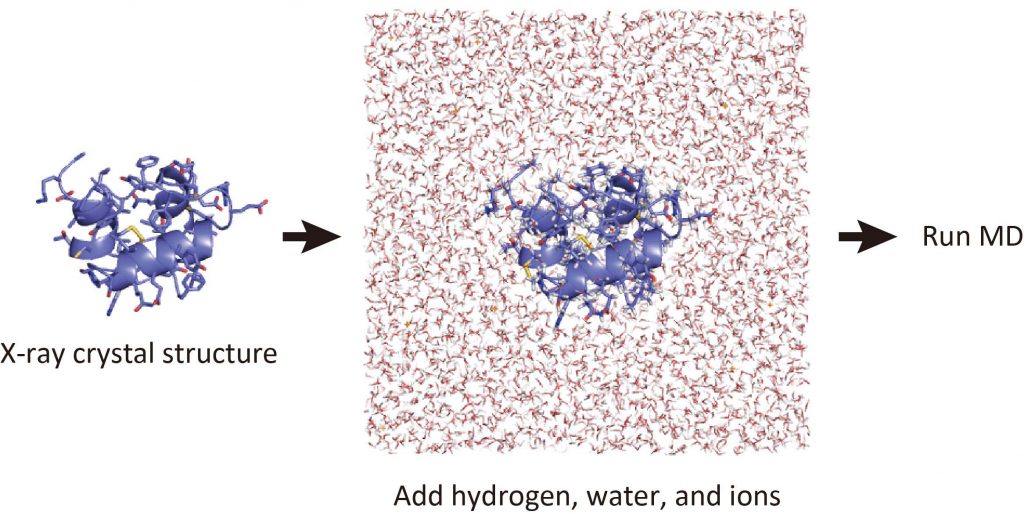
Written by Takaharu Mori@RIKEN Theoretical molecular science laboratory
Dec. 20, 2021

